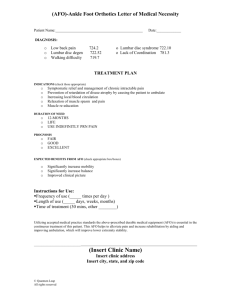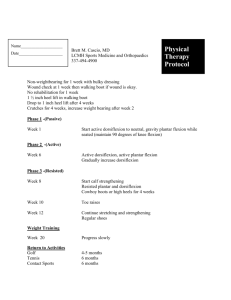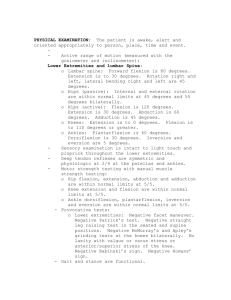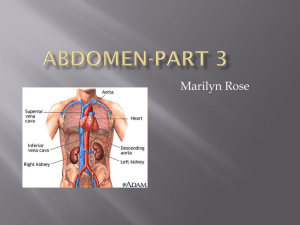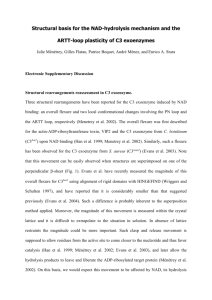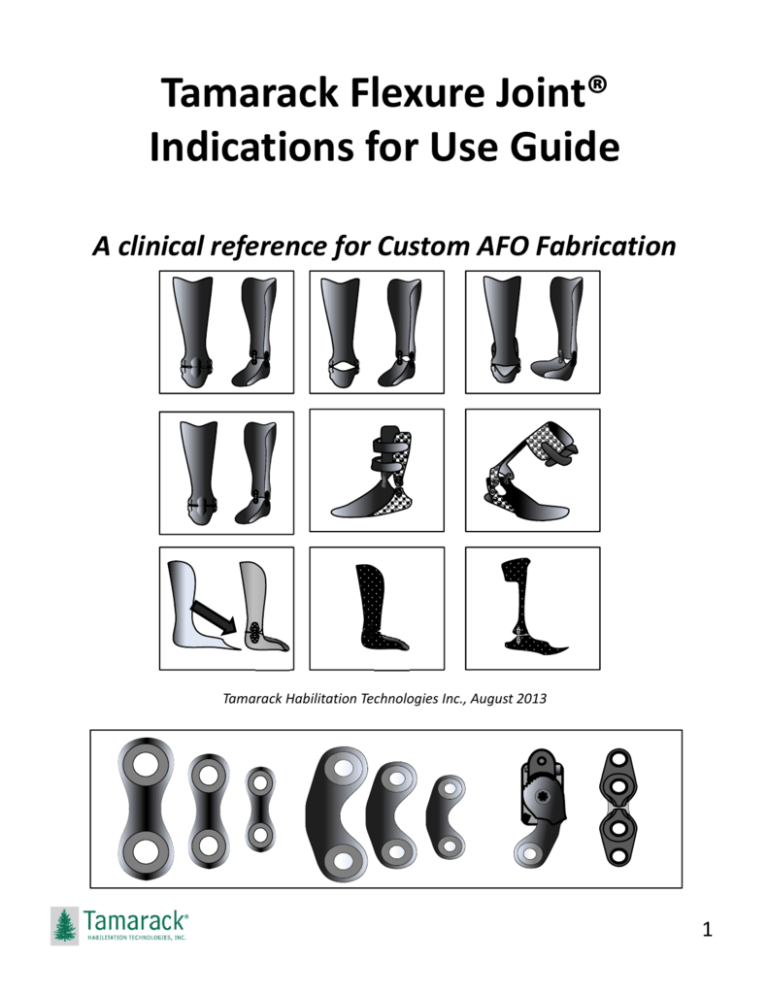
Tamarack Flexure Joint®
Indications for Use Guide
A clinical reference for Custom AFO Fabrication
Tamarack Habilitation Technologies Inc., August 2013
1
Tamarack Flexure Joint® Indications for Use Guide Table of Contents
Acronyms and Terminology used:
IFU: Instruction for Use
AFO: Ankle Foot Orthosis
M‐L: Medio‐Lateral
Plantarflexion – the motion of the foot toward distal (forefoot down)
Dorsiflexion – the motion of the foot toward proximal (forefoot up)
Plantarflexion stop: Device disallowing partial or full plantarflexion
Dorsiflexion stop: Device disallowing partial or full dorsiflexion
Durometer: A unit of measure to describe the level of assist or resistance
offered by a specific material hardness. Application of various durometers
In the Flexure Joint® allows for a wide range of assistive and resistive
response to gait forces.
Page: Content:
2
3
4
5
6
7
8
9
10
11
12
13
14
Table of Contents
Tamarack Flexure Joint® Product Line Overview
AFO w. Free Motion Joints, free plantarflexion and dorsiflexion
AFO w. Free Motion Joints and plantarflexion stop
AFO w. Dorsiflexion Assist Joints and plantarflexion stop
AFO with Variable Assist Joints and hyperextension control strap
PTTD/Stirrup AFO with various joint options
AFO custom composite ‐ with Dorsiflexion Assist Joints
AFO Floor Reaction Orthosis type with Free Motion Flexure Joints
AFO with custom fabricated plantarflexion and dorsiflexion stops
Caps for external mounting and /or retrofitting of joints
Acknowledgements
Disclaimer
2
Tamarack Flexure Joint®
Product Line Overview
Free Motion (Model 740)
Standard Tamarack Flexure Joint® in 3 sizes, and 2 colors.
All Tamarack Flexure Joints® are tested for tensile flexural
durability in cyclic shock application for > 3 Million cycles.
Dorsiflexion Assist (Model 742)
Forefoot lift; in 3 sizes, 2 colors and 3 durometers.
Allows for a wide range of assistive/resistive responses
to gait forces. Choose from light (75‐Shore A),
medium (85‐Shore A) or, strong (95‐Shore A).
Variable Assist (Model 743)
Adjustable forefoot lift, available in 2 sizes.
The Variable Assist consists of a Dorsiflexion Assist type joint
and an adjustment gear drive. It allows for fine‐tuning of
assistive/resistive force by angular pre‐tensioning.
Tamarack Flexure Joint® Caps (Model 741‐CAP)
Alternative prefab joint cavity in 3 sizes and 2 colors.
Designed for external mounting at initial fabrication or retrofit device articulations for both thermoplastic and thermoset AFOs.
Tamarack Flexure Joint is a registered trademark of Tamarack Habilitation Technologies. Manufactured in the U.S.A. 3
Tamarack Flexure Joint® Indications for Use Guide Free Motion AFO
Joint Selection: Free Motion (Model 740)
AFO Design:
• Thermoplastic/fiber/hybrid designs. • Free Motion (Model 740) with full dorsiflexion and plantarflexion.
• Varying footplate lengths.
• All components are waterproof.
Functional considerations:
• Allowing full plantarflexion
and dorsiflexion.
• Frontal plane talar and sub‐
talar joint alignment control.
Clinical Indications:
• Posterior tibial tendon dysfunction
• Frontal plane instabilities of the subtalar and/or talar joint.
Options:
• Proximal closures are required (hook & loop straps or similar ). Clinical Contraindications:
• Weak quadriceps
• Significant sagittal plane ankle weakness/instability
• High impact sports
Drawings do not suggest a particular length of footplate. Footplate length and shoe features have a significant effect on gait safety and gait efficiency.
4
Tamarack Flexure Joint® Indications for Use Guide Plantarflexion Stop AFO
Joint Selection: Free Motion (Model 740)
AFO Design:
• Thermoplastic/fiber/hybrid designs.
• Joint: Free Motion (Model 740) • Plantarflexion stop at desired angle.
• Varying footplate lengths.
• All components are waterproof.
Functional considerations:
• Prevents unwanted plantarflexion
while permitting free dorsiflexion
• Provides M‐L stabilization, talar and subtalar joint stabilization.
Options:
• Proximal closures are required (hook & loop straps or similar ).
• Instep strap may be required • Motion Control: Plantarflexion
stop at desired angle – to be modified by careful grinding.
Clinical Indications:
• Weak dorsiflexors / drop foot
• Tight plantarflexors
• Cerebral palsy
• CVA
• Peroneal nerve paralysis
• Knee hyperextension
• Frontal plane instabilities of the subtalar and/or talar joint.
Clinical Contraindications:
• Weak quadriceps
• Knee flexion contractures
• High impact sports
Drawings do not suggest a particular length of footplate. Footplate length and shoe features have a significant effect on gait safety and gait efficiency.
5
Tamarack Flexure Joint® Indications for Use Guide Dorsiflexion Assist AFO
Joint Selection: Dorsiflexion Assist (Model 742)
AFO design:
• Thermoplastic/fiber/hybrid designs. • Dorsiflexion Assist (Model 742) • Varying footplate lengths.
• All components are waterproof.
Functional considerations:
• Providing dorsiflexion assist with or without plantarflexion stop.
• W/O plantarflexion stop: facilitates more natural first rocker
• Provides a significant dorsiflexion moment.
• Support of ligament instabilities.
Options:
• Joint durometers should be selected/exchanged to provide re‐
quired resistance/assistance .
• Three durometer choices are avail‐
able for this purpose.
• Optional motion control: Plantarflexion
stop at desired angle – to be modified
by careful grinding.
• Proximal closures are required (hook & loop straps or similar ). Clinical Indications:
• CP, CVA, weak dorsiflexors
• Frontal plane instabilities of the subtalar and/or talar joint.
• Peroneal Palsy
Clinical Contraindications:
• Weak Quadriceps
• Spastic plantarflexors
• Knee flexion contracture
• High impact sports
Drawings do not suggest a particular length of footplate. Footplate length and shoe features have a significant effect on gait safety and gait efficiency.
6
Tamarack Flexure Joint® Indications for Use Guide Variable Assist AFO
Joint Selection: Variable Assist (Model 743)
AFO design:
• Thermoplastic/fiber/hybrid designs. • Variable Assist (Model 743)
• Varying footplate lengths.
• All components are waterproof. Metal
parts are stainless steel and bronze.
Functional considerations:
• Lifts foot to prevent foot drop.
• Assistive force for forefoot lift is continuously adjustable
• Hyper‐Dorsiflexion restraint strap
Options:
• Joint is continuously adjustable to in‐
crease/decrease assistive force
• Proximal closures are required (hook & loop straps or similar ). • With or without dorsiflexion restraint strap • Model 743 may be paired with 740 or 742.
Clinical Indications:
• CP, CVA, weak dorsiflexors
• Mild SCI
• Peroneus paralysis
• Pathomechanics of ALS, MD, MS
• Frontal plane subtalar and talar joint
as well as ligament instabilities.
Clinical Contraindications:
• Weak quadriceps
• Un‐controlled fluctuating edema.
• High impact sports
Drawings do not suggest a particular length of footplate. Footplate length and shoe features have a significant effect on gait safety and gait efficiency.
7
Tamarack Flexure Joint® Indications for Use Guide PTTD/Stirrup Style AFO
With custom footplate ‐ Joint Selection: Variable AFO Design:
• Free Motion (Model 740) with optional Model 741 Tamarack Flexure Joint Caps
• Or: w. Dorsiflexion Assist Flexure Joints
• Or: w. Tamarack Flexure Joint® Caps
• Composite or hybrid designs.
• Full range of dorsi/plantarflexion.
• All components are waterproof .
Functional considerations:
• Provides mild M‐L stabilization • Permits free dorsi/ plantarflexion.
• Moderate torsion control.
• Footplate should stabilize subtalar
alignment.
Clinical Indications:
• Posterior tibial tendon dysfunction
• Mild or moderate frontal plane instabilities of talar/subtalar joints.
Options:
• Depending on required resistance/ assistance , joints may be selected/exchanged for various durometers.
• Tamarack Flexure Joint Caps
Clinical Contraindications:
• Weak quadriceps
• Knee flexion contractures
• Spastic plantar flexors
• High impact sports
Drawings do not suggest a particular length of footplate. Footplate length and shoe features have a significant effect on gait safety and gait efficiency.
8
Tamarack Flexure Joint® Indications for Use Guide Dorsiflexion‐Assist Carbon Fiber AFO
Joint Selection: Dorsiflexion Assist (Model 742)
AFO Design:
• Free Motion (Model 740) with optional Model 741 Tamarack Flexure Joint Caps • Composite design.
• Assisted dorsiflexion
• Resisted plantarflexion.
• All components are waterproof Functional considerations:
• Provides dorsiflexion assist with resisted plantarflexion.
• Heavy duty /lightweight design.
• Open frame design (improved air circulation & heat dissipation).
Options:
• Depending on required resistance/ assistance joints may be selected/exchanged for various durometers.
• Tamarack Flexure Joint Caps
Clinical Indications:
• Weak dorsiflexors
• Frontal plane subtalar and talar
joint and ligament instabilities.
• Need for high strength, low profile , lightweight design.
Clinical Contraindications:
• Weak quadriceps
• Knee flexion contractures
Drawings do not suggest a particular length of footplate. Footplate length and shoe features have a significant effect on gait safety and gait efficiency.
9
Tamarack Flexure Joint® Indications for Use Guide Floor Reaction AFO Joint Selection: Free Motion (Model 740)
AFO Design:
• Free Motion (Model 740) with optional Model 741 Tamarack Flexure Joint Caps
• Ground Reaction Force AFO
• Reinforced carbon fiber AFO with posterior entry.
• Dorsiflexion‐stop built in
• All components are waterproof
Functional considerations:
• Heavy duty ‐ lightweight design.
• Open frame design (air exchange).
• Control of knee joint instabilities via rigid, long forefoot lever arm.
• Joint permits plantar flexion • Normalizes gait cycle from heel strike to mid‐stance.
Clinical Indications:
• Mild quadriceps weakness as is typical of ambulatory post‐polio
Options:
• Proximal closures are required (hook & loop straps or similar ). • Tamarack Flexure Joint Caps
Clinical Contraindications:
• Knee flexion contracture
• Complete quadriceps paralysis
• Un‐controlled fluctuating edema.
Drawings do not suggest a particular length of footplate. Footplate length and shoe features have a significant effect on gait safety and gait efficiency.
10
Tamarack Flexure Joint® Indications for Use Guide Custom Fab. Joint Stops
Joint Selection: Free Motion or Dorsiflexion Assist
AFO Design:
• A. Reinforced shell with plantar‐
flexion stop in posterior trim line.
• B. Posterior strap as dorsiflexion control/stop.
A.
B.
Options:
• The dorsiflexion control
strap Is frequently used to avoid overstretch of the Achilles tendon.
• Tamarack Flexure Joint® Caps
Functional considerations:
Use of stops to limit motion:
• A. The plantarflexion stop provides foot drop control. • A. The stop can be adjusted (by grinding) to fine tune joint angle
• B. The dorsiflexion control strap provides sagittal stabilization of the knee (assisting knee extension).
Clinical Indications:
• A. Drop foot
• A. CVA and flaccid paralysis
• B. Moderate weakness of the quadriceps muscle and related knee instabilities.
• B. When adjustable range of
dorsiflexion is required.
11
Tamarack Flexure Joint® Indications for Use Guide Tamarack Flexure Joint® Caps
Joint Selection: Free Motion or Dorsiflexion Assist
AFO design:
• A. Rigid (non‐articulated) AFO for the early phase treatment protocol.
• External Flexure Joint® Caps can be used to transform a non‐articulated (solid) AFO into an articulated design. (Requires Tamarack Flexure Joints) • B. Facilitating installation of Flexure
Joints® in composite materials.
A. A. Functional consideration:
• Easy conversion of a non‐articulated AFO into an articulated one. B. Functional considerations:
• Caps for Composite AFOs
• Eliminates necessity for dummy
• Facilitates manufacturing processes
B. Caps as a joint cavity option for:
Carbon fiber or Pre‐Preg‐AFO
Clinical Indications:
• When the rehabilitation process
allows for/requires increased ROM. • Articulated version when use of dummy
and/or vacuum forming is difficult.
Clinical Contraindications:
• Weak quadriceps
• Un‐controlled fluctuating edema
• High impact sports
Drawings do not suggest a particular length of footplate. Footplate length and shoe features have a significant effect on gait safety and gait efficiency.
12
Tamarack Flexure Joint® Indications for Use Guide Acknowledgements
The Tamarack Flexure Joint® Indications for Use Guide was designed by Wieland Kaphingst, CPO of Tamarack Habilitation Technologies and edited by the following clinical experts:
Gary Bedard, CO
Daniel Brams, CPO
Charles Kuffel, CPO
Nick LeCursi, CO
Peter Poetsma, CPO
Wilfried Raab, CPO
Phil Stevens, CPO
Heinz Trebbin, CPO
© 2013 Tamarack Habilitation Technologies. All Rights Reserved
13
Tamarack Flexure Joint® Indications for Use Guide Disclaimer
The Tamarack Flexure Joint® Indications for Use Guide
was designed by Tamarack Habilitation Technologies Inc. and was clinically edited by external professional peers.
The Guide cannot be considered the sole determinant of the optimal solution for any specific individual with a disability, pathology or trauma‐related orthotic problem. Individual cases may vary greatly from any norm. Departures from componentry and other design features suggested in this document may therefore be appropriate in such cases. 1670 ‐ 94th Lane NE, Minneapolis, MN 55449 USA
Tel: ++ 763‐795‐0057 Toll‐Free: 1‐866‐795‐0057
Visit our website: www.tamarackhti.com
14


